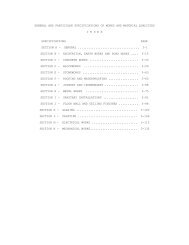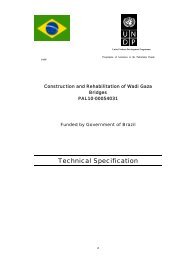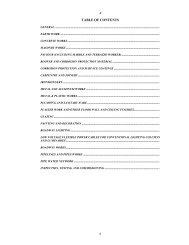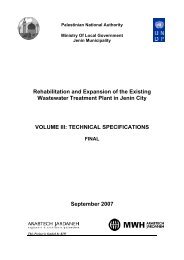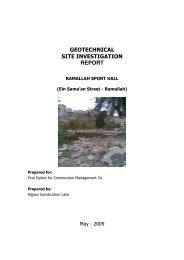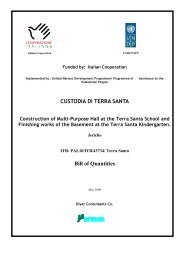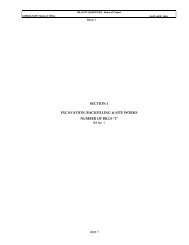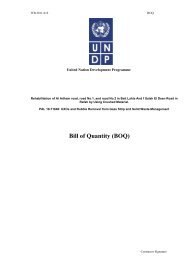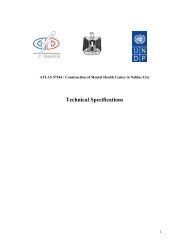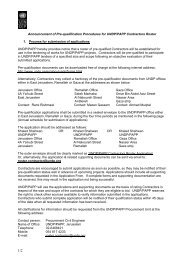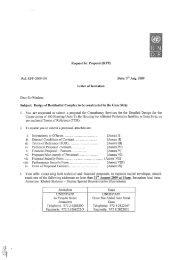EIA Study- Final Report-May 10 - UNDP
EIA Study- Final Report-May 10 - UNDP
EIA Study- Final Report-May 10 - UNDP
You also want an ePaper? Increase the reach of your titles
YUMPU automatically turns print PDFs into web optimized ePapers that Google loves.
Environmental Impact Assessment<br />
Khan Younis Wastewater Treatment Plant <strong>May</strong> 20<strong>10</strong><br />
Applied to secondary treated wastewater, sand filtration allows 50-80% reduction of<br />
suspended solids and 30 to 40% reduction of BOD 5 .<br />
The wastewater treated in the previous process units can meet all standards except for<br />
pathogens. Very good removal of nematodes eggs is achieved by tertiary sand filtration.<br />
However, for other pathogens, an additional treatment step is required in order to achieve<br />
full compliance.<br />
In case of KY WWTP disinfection by UV radiation is proposed, which does not create<br />
any byproducts. However, powerful UV lamps are required. In UV disinfection systems,<br />
the UV light is produced by germicidal lamps, which are submerged in an open channel.<br />
As the wastewater flow passes the UV lamps, the microorganisms are exposed to a lethal<br />
dose of UV energy. UV-rays penetrate through small particles and attack micro<br />
organisms at their DNA/RNA-core. This mechanism causes inability to replicate.<br />
4.2.3.4. Sludge Treatment<br />
Sludge balance:<br />
Sludge treatment works are designed for the following sludge production:<br />
• Sludge production – Phase 1................................11612 kg DS/day<br />
• Sludge production – Phase 2................................18202 kg DS/day<br />
• Excess sludge concentration ................................................8.5 g/l<br />
• Excess sludge volume – Phase 1................................ 1314 m3/day<br />
• Excess sludge volume – Phase 2................................ 2054 m3/day<br />
Gravity thickener:<br />
Thickening is the first stage in reducing the volume of the sludge. The thickening process<br />
usually corresponds to an increase in the concentration of the sludge collected in the final<br />
sedimentation tanks.<br />
Gravity thickeners are designed on the basis of hydraulic surface loading and solids<br />
loading. In order to minimize operating costs, no chemicals are added for sludge<br />
treatment at KY WWTP.<br />
Biological excess sludge enters the thickeners from above and thickener feeding is<br />
continuously. Thickeners are fitted with a centrally driven rotary mechanism with a<br />
diametric bridge.<br />
Scrapers positioned directly above the thickener floor transfer the deposited sludge to a<br />
central hopper from where it is recovered by gravity flow to the sludge pumping station.<br />
A vertically mounted picket fence is also attached to the rotary mechanism and enhances<br />
the release of interstitial water and gas contained in the sludge and allows therefore<br />
correct sludge settling and thickening conditions in the tank.<br />
Sludge drying:<br />
SOGREAH/UG CONSULTANTS 44



